| Sunda flying lemur | |
|---|---|

| |
| Sunda flying lemur | |
| Scientific classification | |
| Domain: | Eukaryota |
| Kingdom: | Animalia |
| Phylum: | Chordata |
| Class: | Mammalia |
| Order: | Dermoptera |
| Family: | Cynocephalidae |
| Genus: | Galeopterus Thomas, 1908 |
| Species: | G. variegatus[1]
|
| Binomial name | |
| Galeopterus variegatus[1] (Audebert, 1799)
| |

| |
| Sunda flying lemur range | |
| Synonyms[3]: 241, 252 | |
| |
The Sunda flying lemur (Galeopterus variegatus), also called Malayan flying lemur and Malayan colugo is the sole colugo species of the genus Galeopterus.[1] It is native to Southeast Asia from southern Myanmar, Thailand, southern Vietnam, Malaysia to Singapore and Indonesia and listed as Least Concern on the IUCN Red List.[2] Although it is called "flying lemur", it cannot fly but glides among trees and is strictly arboreal. It is active at night, and feeds on soft plant parts such as young leaves, shoots, flowers, and fruits. It is a forest-dependent species.
The Sunda flying lemur is protected by national legislation. The Sunda flying lemurs are often hunted by local people with spears or other lethal equipment for various reasons such as food and fur. Habitat loss is known to occur intermittently, particularly in developing countries such as Malaysia.[4]
- ^ a b Stafford, B.J. (2005). "Order Dermoptera". In Wilson, D.E.; Reeder, D.M (eds.). Mammal Species of the World: A Taxonomic and Geographic Reference (3rd ed.). Johns Hopkins University Press. p. 110. ISBN 978-0-8018-8221-0. OCLC 62265494.
- ^ a b Boeadi.; Steinmetz, R. (2008). "Galeopterus variegatus". IUCN Red List of Threatened Species. 2008: e.T41502A10479343. doi:10.2305/IUCN.UK.2008.RLTS.T41502A10479343.en. Retrieved 16 March 2024.
- ^ Chapman, H.C. (1902). "Observations upon Galeopithecus volans". Proceedings of the Academy of the Academy of Natural Sciences of Philadelphia. 54: 241–254.
- ^ Nasir, M. D. & Abdullah, M. T. (2010). "Distribution of the Sunda Colugo (Galeopterus variegatus) in Malaysia (Peninsular, Sabah, Sarawak)". Tropical Life Sciences Research. 21 (2): 69–83. PMC 3819077. PMID 24575200.
